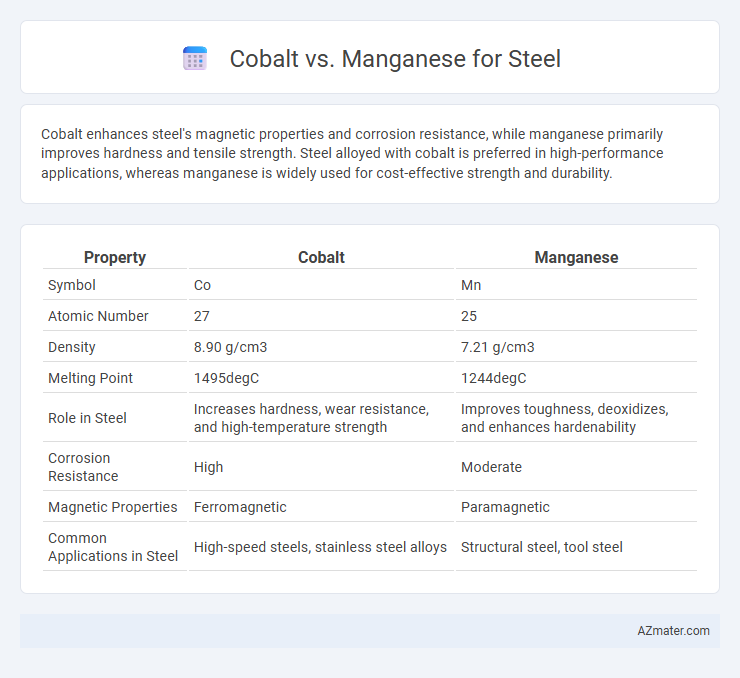Cobalt enhances steel's magnetic properties and corrosion resistance, while manganese primarily improves hardness and tensile strength. Steel alloyed with cobalt is preferred in high-performance applications, whereas manganese is widely used for cost-effective strength and durability.
Table of Comparison
| Property | Cobalt | Manganese |
|---|---|---|
| Symbol | Co | Mn |
| Atomic Number | 27 | 25 |
| Density | 8.90 g/cm3 | 7.21 g/cm3 |
| Melting Point | 1495degC | 1244degC |
| Role in Steel | Increases hardness, wear resistance, and high-temperature strength | Improves toughness, deoxidizes, and enhances hardenability |
| Corrosion Resistance | High | Moderate |
| Magnetic Properties | Ferromagnetic | Paramagnetic |
| Common Applications in Steel | High-speed steels, stainless steel alloys | Structural steel, tool steel |
Introduction to Cobalt and Manganese in Steel
Cobalt and manganese are critical alloying elements used in steel production to enhance mechanical properties and corrosion resistance. Cobalt improves hardness, strength, and high-temperature stability, making it essential in tool steels and specialty alloys. Manganese acts as a deoxidizer and desulfurizer, increasing toughness and wear resistance in carbon and alloy steels, while also improving hardenability and tensile strength.
Chemical Properties and Composition
Cobalt enhances steel by increasing hardness, wear resistance, and corrosion resistance through its ability to form stable carbides and maintain microstructural stability at high temperatures. Manganese acts as a deoxidizer and alloying element that improves tensile strength, toughness, and resistance to abrasion by forming manganese sulfides and modifying the steel's grain structure. The chemical composition typically includes 0.1-5% cobalt for specialized applications, while manganese content ranges between 0.3-2% in most steels to optimize mechanical properties and processing characteristics.
Impact on Steel Microstructure
Cobalt enhances steel microstructure by promoting grain refinement and improving carbide stability, which leads to increased hardness and wear resistance. Manganese acts as a deoxidizer and combines with sulfur to form MnS inclusions that improve toughness and reduce brittleness in steel. The combined presence of cobalt and manganese contributes to a balanced microstructure with enhanced mechanical properties, especially in high-speed and wear-resistant steels.
Strength and Hardness Comparison
Cobalt significantly enhances steel's strength and hardness by improving its wear resistance and high-temperature stability, making it ideal for cutting tools and high-performance alloys. Manganese primarily boosts steel's toughness and tensile strength by refining grain structure and increasing hardness through solid solution strengthening. While cobalt provides superior hardness and heat resistance, manganese offers a balanced combination of strength and ductility in steel applications.
Corrosion Resistance Capabilities
Cobalt enhances steel corrosion resistance by forming a stable oxide layer that protects against oxidation and chemical attack, making it ideal for high-temperature and acidic environments. Manganese contributes to corrosion resistance by improving steel's toughness and deoxidizing properties, but it is less effective than cobalt in harsh corrosive conditions. Steel alloys with cobalt typically outperform manganese-containing steels in resisting rust and maintaining structural integrity in aggressive environments.
Influence on Weldability
Cobalt enhances steel's hardness and wear resistance but can reduce weldability due to increased cracking susceptibility during cooling. Manganese improves weldability by acting as a deoxidizer and sulfur fixer, minimizing the risk of weld defects like hot cracking. The balance between cobalt and manganese content plays a critical role in optimizing both mechanical properties and weld quality in steel alloys.
Cost and Availability Analysis
Cobalt is significantly more expensive than manganese due to its scarcity and higher demand in specialized industries like batteries and superalloys. Manganese, being more abundant and widely mined globally, offers a cost-effective alternative for steel production, primarily serving as a deoxidizer and alloying agent to enhance hardness and strength. The broader availability and lower market price of manganese make it the preferred choice for large-scale steel manufacturing compared to cobalt's limited and costly application.
Environmental and Health Considerations
Cobalt and manganese are critical elements in steel production, each presenting distinct environmental and health challenges. Cobalt mining often leads to significant ecological disruption and raises concerns due to its toxicity and potential for human exposure, particularly in artisanal mining regions. Manganese, while essential for steel's strength and durability, can cause respiratory issues and neurological effects when airborne dust is inhaled during mining and processing, emphasizing the need for stringent occupational safety measures.
Common Industrial Applications
Cobalt enhances steel's hardness and corrosion resistance, making it ideal for high-performance tools, aerospace components, and cutting instruments. Manganese is primarily used as a deoxidizer and sulfur fixer, improving steel's toughness and wear resistance in construction materials, railroads, and automotive manufacturing. Both elements play critical roles in steel alloys, optimizing mechanical properties for industrial applications requiring strength and durability.
Choosing the Right Alloying Element for Specific Needs
Cobalt enhances steel's wear resistance and retains strength at high temperatures, making it ideal for aerospace and cutting tools, while manganese improves hardness, tensile strength, and toughness, commonly used in structural steel and pipelines. Selecting cobalt alloys benefits applications requiring corrosion resistance and thermal stability, whereas manganese alloys excel in impact resistance and deoxidation during steelmaking. Understanding the mechanical properties and environmental conditions is crucial for optimizing steel performance with the right alloying element.

Infographic: Cobalt vs Manganese for Steel
 azmater.com
azmater.com